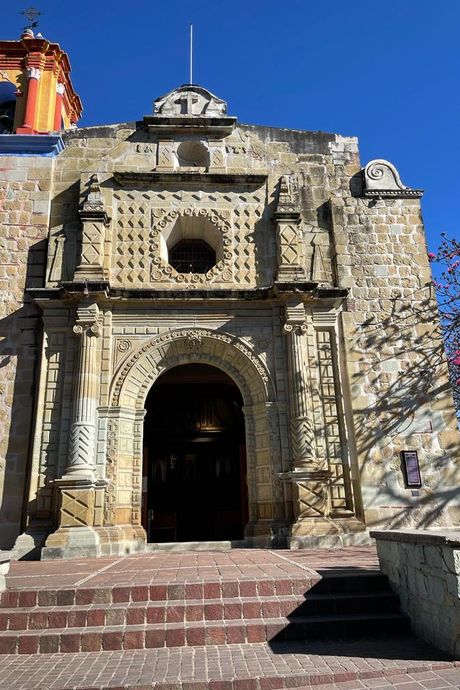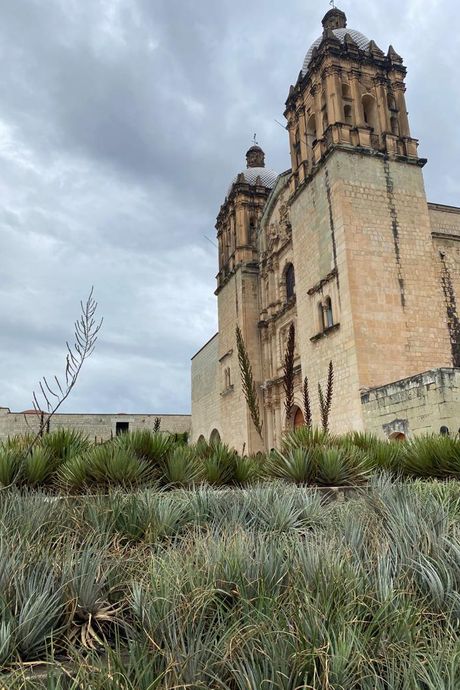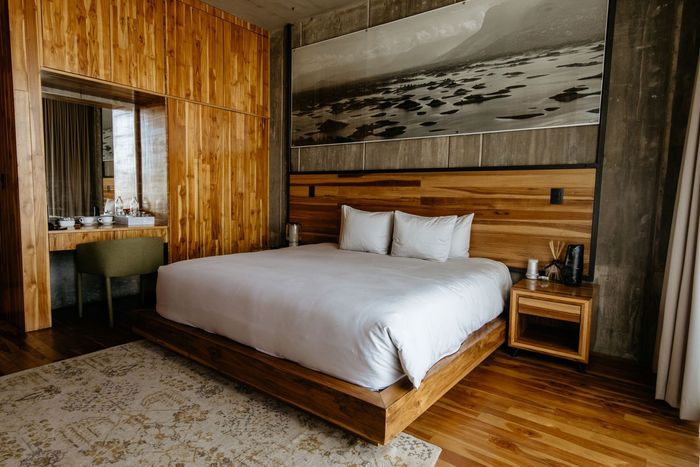
Everyone knows that person who spends weeks sniffing around travel blogs, going deep into Tripadvisor rabbit holes, collecting Google docs from friends of friends, and creating A Beautiful Mind–style spreadsheets to come up with the best vacations and itineraries possible. In this recurring series, we find those people who’ve done all the work for you and have them walk us through a particularly wonderful, especially well-thought-out vacation they took that you can actually steal.
Agua Magica founder Rafa Shin grew up in Mexico City, but his family would often travel to Oaxaca, and now, as an adult, he’s amassed a group of friends who call the city home. “I’m a little obsessed with this part of Mexico,” he says. “I discover and learn something new every trip.” While he’s based in New York, Shin frequently finds himself in the city for business since his mezcal brand’s palenque is located right outside town. This past July, he headed down for Guelaguetza, a traditional festival that highlights the Indigenous tribes of the state. “This is one of my favorite times to visit because I get to truly experience the pride and love that Oaxacans have for their state. You can see everyone celebrate their cultures and customs from all eight regions in one go.” The four-day trip was filled with lots of mole and mezcal, tours of traditional ruins, and pork tacos so good one of Mexico’s ex-presidents would allegedly call in an order.
Day 1
3.p.m.: Drop your bags and sip a mezcalito.
My flight landed in Oaxaca, and I took a cab to check into Flavia (Calle de la Cruz 7, Sal Felipe del Agua). The luxury hotel is located in the San Felipe del Agua neighborhood, which was once a small town on the outskirts and over time has been enveloped by Oaxaca itself. It’s about a 15- to 20-minute drive to the center of town, but it’s worth staying, if only for the view and décor. Every room is different. I checked into the Copal room, which has a balcony with the most striking view of the city. If you stay here, definitely try to book this one. Once I was checked in, I immediately headed to the roof for a mezcalito — it’s the perfect way to reset.
5 p.m.: Explore Jalatlaco.
Most tourists like to wander around the historic city center first, but I made it a point to go to the cobblestone streets of El Barrio de Jalatlaco. In my opinion, this barrio is just as beautiful and much less crowded. I admired the colorful buildings and historical architecture before stopping off at a random café to grab a coffee. A local and I made some small talk, and for a moment, time felt like it stood still, so it was a very relaxing start to my trip.


8 p.m.: Order a double serving of fish and rice.
Every local loves the tomato salad at Levadura de Olla (C. Manuel Garcia Vigil 304) because it’s this beautiful mix of different sizes and shapes laid out in a perfect circle like a work of art. Usually that’s my favorite, too, but this time I added the fish-with-rice dish to my order. The dish comes as a bed of rice cooked in tomato sauce, topped with super-fresh grilled fish and aioli. It’s so good that I immediately ordered another. I also ordered a homemade pulque (a drink made from fermented agave sap), which kind of tastes like a delicious kombucha. The place looks quite traditional and is very pared back yet elegant. It also has a room used solely to present fresh tomatoes. I have a great respect for Thalia, the owner and head chef. I love how she’s woven her heritage and ingredients from where she grew up, in the remote village of San Mateo Yucutindoo, into her cooking. After this meal, I called it a night and head back to the hotel.
Another option is checking out her cocina de humo, where you can sit for a tasting menu and watch her team at work in front of you, making everything from homemade tortillas to huevito al comal (eggs baked on open fire).
Day 2
8:30 a.m.: Eat the best almond croissant in North America.
I woke up and took a cab into the center of town because I needed to grab a pastry at Boulenc (C. Porfirio Díaz 207, Rua Indepencia, Centro, 68000). It’s an artisanal panaderia that always has a crowd in front. I ordered the almond croissant because I’m constantly craving it when I’m not in town. It’s flaky, delicious, and perfectly sweet. After eating one outside, I crossed the street to Kiyo Café (Porfirio Diaz #212) for some seriously delicious coffee. It’s a very cool shop that also has its own boutique and fashion line. I checked out a printed shirt as well as some of their tees that feature a collaboration with graphic designer Moriz Oberberger. I also popped into Suculenta, a seasonal provisions store (Porfirio Diaz #211), to stock up its salsas and jams. It’s quite dark in there with items piled up to the ceilings and a natural wine nook in the back. I bought guava marmalade and salsa macha (chili oil).


10 a.m.: Meet friends to explore the historic district.
I happened to be here the last week of July, during the Guelaguetza festival, which is the largest display of Indigenous cultures in Mexico. Oaxacans from all eight regions throughout the state head here for a festival that features dances that represent their traditions. The main show is at an open-air arena that you can see from the city center, but you’ll also find spontaneous parades that wind around town. Definitely don’t miss the Flor de Piña dance: I won’t give much away, but the crowd goes wild for it.


I met up with my friends who happen to be in town for the festival and we walked over to Santo Domingo Church (C. Macedonio Alcalá), which is the true center of town. I love how it showcases the mysticism and religious traditions of the state. We meandered through the center of the building and looked up at all of the gilded details before heading over to the nearby Jardin Etnobotanico, the botanical gardens next to Santo Domingo and a great example of the biodiversity of the state.


2 p.m.: Stroll the open-air markets for chorizo and fresh fruit.
By this time, we were hungry, and it’s time for lunch at Benito Juárez Market Oaxaca (Las Casas S/N).The best way to do it, especially if you speak Spanish or have a friend in your group who does, is by taking a tour with Mario López of Mario Come Oaxaca. Although he doesn’t speak English, he’s very animated, and somehow you understand what he’s telling you. Mario is incredibly knowledgeable about the history of Oaxacan cuisine, so you learn something new every time. He takes us to the agua fresca stall on the far left of the building near one of the exits and tells us how the owner, who is a staple at the mercado, is known to give drinks to those who can’t afford them. We picked up a few flavors like watermelon and pineapple before walking across to Mercado 20 Noviembre (20 Noviembre 512). Mario makes a beeline for the el pasillo de humo, which is a corridor filled with vendors who grill your food after you select your meat. You can find everything from chorizo to cow udders. We grab an order of the tasajo (thin strips of beef), cecina (thin dried strips of beef), and chorizo with side orders of tortillas and salsas.


8 p.m.: Order aguachile and mole at Criollo.
If there’s one spot I never miss for dinner, it’d be Criollo (Calzada Madero 129), which is one of renowned Mexican chef Enrique Olvera’s other spots besides Pujol in Mexico City and Cosme and Atla in New York. The tasting menu this time featured a super-fresh aguachile with tomatoes and crunchy raw green beans as well as a crispy pork belly dish over a bed of mole. You can’t come to Oaxaca and not have mole every day. I also drank a mezcal cocktail that included beer, grapefruit, and honey. It sounded odd but was unexpectedly delicious. We sat in the back garden, which has several chickens and very fat bunnies running around the property. Don’t worry — they’re pets and not on the menu.


Day 3
7 a.m.: Get in an early morning hike.
We called a taxi and went to Teotitlán, which is 45 minutes from Oaxaca. The town is best known for its textiles and candles, but before we shopped, we went for an hour hike in the Picacho, which has the best views of the town. The entire route takes about three miles total, but depending on your level of fitness, it can be done in about an hour. We didn’t find it too hard, and we were all in sneakers. After we got back down, we decided to skip breakfast because I made reservations for my favorite restaurant in all Oaxaca. I bribed everyone with promises that it’ll be the best lunch they’ll ever eat.


9 a.m.: Buy beeswax candles for everyone back home.
Teotitlán has incredible wool textile shops, if you’re in the market for a new rug, but we went straight to Casa Viviana (Abasolo s/n, Centro, 70420 Teotitlán del Valle). The historic candle shop is known for its velas and other ornamental candles that are made with naturally dyed beeswax cast in complex molds. Doña Viviana has a spectacular story. After her husband fell ill, she opened up her atelier and began selling her candles to earn money to raise her family. This angered the elders of the village since it broke with tradition of bartering these candles for food with the Catholic Church. Despite this, her store has become successful. My company buys candles from her about once a month for all of our events in New York City, and everyone is obsessed with them. Just know that they’re very fragile, so pack them carefully.


2 p.m.: Order more mole.
At this point, we were starving, but it’s well worth saving the stomach space for a late lunch at Alfonsina (C. García Vigil 183). Jorge León, the chef here, used to work at Pujol in Mexico City. He saved up money so he could return to his hometown to open up Alfonsina in the house he grew up in along with his mother, Elvia. The outdoor space features beautiful pottery, but the highlight is the seasonal menu. Everyone raved about the mole being the best they’ve ever had, including the locals in our group. It was smoky, sweet, and trust me, every last bite was soaked up with the fresh tortillas. The tamales wrapped with hoja santa was another highlight — the fragrant herb used has such a unique flavor that’s so hard to put into words, so just try it.


6 p.m.: Sip some digestion-aiding mezcal.
Mezcal has been traditionally used to help with digestion, so on that note, we decided to go back to Centro and have cocktails at Selva Cocktail Bar (C. Macedonio Alcalá 403-int. 6). The place is very dramatic and sultry, which makes ordering a drink feel like you’re a film-noir extra. We order a round of unique creations. The sherry and shiitake mushroom one was … interesting? Everyone agrees the Energetic cocktail made with pulque and passion fruit is the sleeper hit.


8 p.m.: Grab a few pork tacos.
Somehow the drinks revived us, so we decided our stomachs could fit a few tacos. The only place to go is Tacos Sierra (Miguel Hidalgo 1310), a taqueria that the locals love. And, allegedly, one of Mexico’s ex-presidents would to send his plane here to pick up these tacos and deliver them to Los Pinos, a.k.a. the Mexican White House. There’s only one option of meat here, which is pork, so you really can’t go wrong. We got an order of tacos, tortas, and tostadas, and they were absolutely delicious. I crave this place, and sometimes I’ll even go there twice a week when I’m visiting.
Day 4
7 a.m.: Wake up early to see the ruins.
Another morning, another early wake-up. But it’s worth it to see the most iconic ruins in Oaxaca, the Monte Albán Ruins (Ignacio Bernal S/N, San Pedro Ixtlahuaca). If you don’t arrive by 8 a.m., it starts to fill up and you might not be able to see everything. The site is known for the Zapotec and Mixtec architecture. I took the group to the Gran Plaza, which is the sprawling center, and then we saw Los Dazantes, which are these massive stone monuments featuring contorted figures.
9 a.m.: Have a traditional Oaxacan breakfast.
Breakfast at Catedral (C. de Manuel García Vigil 105) includes Oaxacan classics like enfrijoladas con cecina, which are similar to quesadillas and are served with a bean sauce. We also got enmoladas, which are tacos covered in a mole sauce, and a cup of Oaxacan hot chocolate, a really light chocolate drink made with a base of either water or milk and mixed in with spices like cinnamon.
11 a.m.: Shop for local pottery and textiles.
We stopped by Aripo (Calle de Manuel García Vigil 809), which has everything from pottery to woven textiles to artwork. Everything is made across Oaxaca state, so you’re supporting local artisans. This store is one of the reasons I always check a bag, but this time I don’t buy anything because our next stop is Cooperativa 1050. The collective pairs traditional makers with contemporary designers to create modern versions of barro, the black- or red-clay pottery traditionally used in this area. This time around, many of the pieces were sold out — great for the store, not great for me. We also went to Sombreros Alberly (Zaragoza numero 7), where they’ll custom make any hat you want for a reasonable price. I bought a dark green one for $110.
Across from the main church is Artesanias Juana Cata (C. de Gurrión 110), which Google mistakenly has marked temporarily closed, but it’s not. The store is filled from floor to ceiling with cotton dresses, shirts, and pants. Don’t be afraid to jump into the piles and mess everything up to find the perfect piece. The owners are well aware you’ll do that and somehow manage to magically make the stacks immaculate after you leave. Everything is priced under $100, and the place is best known for its unique dyes, including some very cool one-of-a-kind tie-dye button-downs.


Our last stop is Xaquixe (C. de José María Pino Suárez 104), which is a recycled-glass workshop. We value the tradition of sobremesa in Mexico — it’s the act of relaxing at the lunch or dinner table after a heavy meal, usually accompanied with a glass of mezcal as a digestif and some cigars. This glassware is what you’ll find on my table at sobremesa.
6 p.m.: Drink more mezcal.
When I was developing my brand we’d go to Mezcaloteca (Reforma No. 506) and spend many late nights there. It’s like a library full of incredible drinks. I always make it a point to bring friends so they can taste all the varieties of mezcal.
8 p.m.: Order a side of grasshoppers.
After a few rounds of mezcal, we’re ready to eat again, and I booked a table outside at Casa Oaxaca (Constitución #104-a). The view of Santo Domingo Church at night is amazing. We ordered the insect tostada, which is a tortilla served with agave worms, grasshoppers, chicatana ants, and guacamole. Eating insects is huge here, and the flavor is earthy and delicious. For those who decided to abstain from the bugs, we ordered the wedding-stew tacos.


Day 5
9 a.m.: Have a solo breakfast.
Once my friends left, I get into the business portion of my trip. I started with a cold brew and a breakfast sandwich at Muss Café (Miguel Hidalgo 911).
10 a.m.: Visit the palenque.
One of the more popular day trips while you’re in Oaxaca is to visit the palenques, which are located outside of town. It’s worth a trip to see how this traditional mezcal is made. I head out to visit the one where we make ours, which is located in San Juan del Rio, about 90 minutes from the city center.
I met our maestro mezcalero Rogelio Juan Hernandez in a gas station. He offered me a taste of his mezcal, and it was the best I’ve ever tasted. I get to the palenque to discuss business, but we wind up chatting about everything else from his family to the new roads in town to a few new ideas I’m working on.


Rafa’s Oaxaca packing list
I’ve had the same pair for over seven years, and they’re so comfortable. I love that they work in the city as well as when I’m on the palenque.
After a long flight, the first thing I need is a clean shave. This kit is a space saver and makes my face feel supersmooth.
For a breezy shirt that travels well and can withstand the summer heat in Oaxaca, there’s nothing better than this linen one by Tombolo. You can roll it up tightly in your suitcase to save space, but it’ll still look presentable once you wear it.
I always need a good pair of sunglasses ,and this one is my current favorite. The shape is classic, and it’s well priced, which is great in case I lose them on the trip.
Some rolling luggage we've written about
The Strategist is designed to surface the most useful, expert recommendations for things to buy across the vast e-commerce landscape. Some of our latest conquests include the best acne treatments, rolling luggage, pillows for side sleepers, natural anxiety remedies, and bath towels. We update links when possible, but note that deals can expire and all prices are subject to change.


















